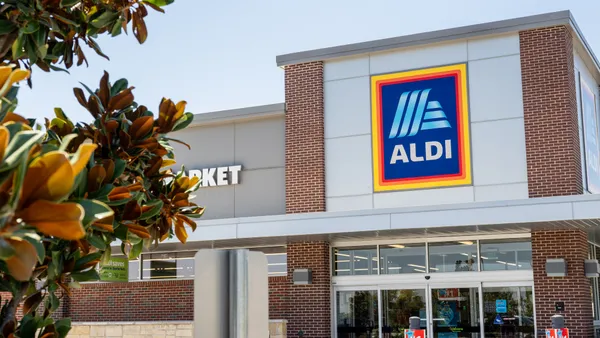Dive Brief:
- Nearly 37% of U.S. shoppers have purchased groceries online in the past year, up from 23% the year prior, according to Coresight Research’s US Online Grocery Survey 2019. That growth translates to almost 35 million more consumers tapping digital commerce from 2018 to 2019 than the previous year.
- Only 11.8% of consumers report using delivery to buy "a lot" of their groceries online, while nearly three-quarters use online channels to purchase a smaller proportion.
- Amazon remains dominant in the online grocery space, with 62.5% of shoppers who bought groceries online in the past year purchasing from Amazon.com. Walmart’s online shopping contingent grew from 25.5% in 2018 to 37.4% in 2019, and Target’s online shopping base more than doubled with 15.7% of shoppers buying groceries from Target.com in the past year.
Dive Insight:
Online grocery is one of the most talked about segments as countless retailers try to woo consumers with speedy delivery, discounts and fresh product offerings. Despite the hype, however, only 2.2% of food and beverage sales in the U.S. were completed through online channels during 2018, according to the report.
Amazon remains in first place when it comes to online grocery, largely due to its strong Prime membership base. Sixty-eight percent of Prime members purchased groceries online through Amazon.com in the last year compared to 44% who do not have a Prime membership. Despite this strong showing, Amazon grocery shoppers tend to use the service only occasionally and to purchase a small number of items at a time, according to the research.
The retail giant seems to be fast at work to change this and drive bigger, more frequent baskets. The company recently announced one-day delivery, added condiments to its growing private label line and has shared plans to launch a new grocery chain.
If there’s anyone that Amazon should be watching carefully in the online grocery delivery race it’s Walmart. Standing in second place in terms of popularity, Walmart managed to nearly double the number of shoppers purchasing groceries through its online channels in just one year, and more shoppers (35%) report using the service for larger grocery hauls than Amazon.
Walmart has placed a strong emphasis on boosting its online grocery business, and its efforts seem to be paying off. The company currently offers grocery pickup at approximately 2,000 stores with plans to add 1,000 more locations by the end of 2019 and grocery delivery, now available at more than 800 stores, is projected to double this year.
Target is another notable player, tripling its online shopping numbers in 2018. Kroger also doubled its online grocery shopping numbers, adding 6 million new users last year, the report said.
Unlike Amazon users, Walmart and Target shoppers tend to buy larger numbers of items per transaction. This suggests that capturing the "full-basket" crowd could be the key to dominating the online grocery game. One of the biggest hesitations that some people have about online grocery is letting a stranger pick out their food items, preferring to touch, feel and see things like produce for themselves. The shift toward using Walmart and Target for full grocery trips online suggests that these retailers are doing something right to win shoppers’ trust.
Coresight predicts that online grocery will make a small climb to 2.7% in 2019, indicating that shoppers still seem to prefer to go to the store to complete large purchases. The fact that shoppers seem to use online grocery for smaller trips suggests that the service could be used to find hard-to-locate specialty products or to hunt for more favorable prices on items that people don’t want to pick up in a store.
While shoppers across the board are giving online grocery a chance, older millennials between the ages of 30 to 44 were primary drivers of the growth due to their familiarity with technology, rising incomes and settled professional and family lives.









